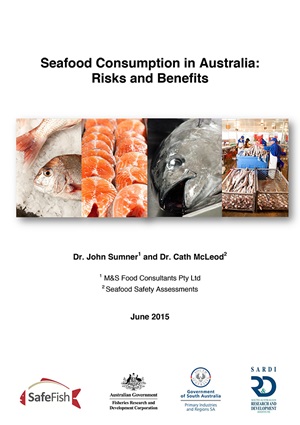A new SafeFish report highlights species selection for low-risk, high-benefit seafood
By Gio Braidotti

A flurry of recent media articles, particularly in the US, have highlighted concerns about mercury in seafood and potential risks for consumers. Yet aquatic seafood is well known to have health benefits, particularly for infants and pregnant women. How should consumers weigh up the health benefits of consuming aquatic seafood alongside the potential risks?
To help make sense of conflicting health recommendations and warnings, the Australian national advisory body SafeFish has brought together the best available evidence-based consumer advice. Supported by several government and seafood-sector partners, including the FRDC, SafeFish specialises in seafood safety and hygiene. Its report Mercury and Omega-3 Oils in Australian Seafood was released last year.
Overall, the data indicates that the levels of mercury in most seafood consumed in Australia are low and that seafood’s heath
benefits generally outweigh mercury risks.
The report concluded that following the recommended national dietary guidelines is the best way to balance risks and benefits (Table 1).
The report included information from the 2010 Expert Consultation on the Risks and Benefits of Fish Consumption established by the Food and Agriculture Organization of the United Nations (FAO) and the World Health Organization that drew on experts in nutrition, toxicology, epidemiology, dietary exposure and risk assessment.
| Fish species | Pregnant women (1 serve = 150 grams) |
Children 0 to 6 yrs (1 serve = 75 grams) |
|---|---|---|
| Any fish and seafood other than: Orange Roughy, Catfish, shark, billfish (Swordfish, Broadbill, Marlin) |
2–3 serves per week |
2–3 serves per week |
| Orange Roughy or Catfish and no other fish that week | 1 serve per week |
1 serve per week |
| Shark or billfish (Swordfish, Broadbill, Marlin) and no other fish that fortnight | 1 serve per fortnight |
1 serve per fortnight |
| Rest of the population (1 serve = 150 grams) | ||
| Any fish and seafood other than: shark, billfish (Swordfish, Broadbill, Marlin) |
2–3 serves per week |
|
| Shark or billfish (Swordfish, Broadbill, Marlin) and no other fish that week |
1 serve per week |
|
Species selection
Overall, SafeFish found that mercury levels in most Australian seafood are low (less than 0.5 milligrams per kilogram) and are not an issue for the general population.
Seafood with low mercury levels include finfish such as Atlantic Salmon, Bream, canned tuna, Snapper, Trevally, Whiting and Flathead, crustaceans and molluscs.
The highest levels of omega-3 fatty acids in Australian fish were found in farmed species – Atlantic Salmon, Rainbow Trout and Yellowtail Kingfish. That means options with low-risk and high-benefit ratios exist and these include mackerels and sardines. Collectively, Australians consume about 1.8 billion servings (150 grams) of this seafood a year.
Given that 72 per cent of seafood consumed in Australia is imported (2008–09 figures), imported seafood was also examined. SafeFish reports that the Australian Total Diet Study, conducted by Food Standards Australia New Zealand (FSANZ) in 2011, found low concentrations of mercury in battered fish fillets, frozen fish portions, tuna canned in brine and cooked prawns, which are some of the most commonly consumed seafood products in Australia.
Mercury, however, does accumulate in aquatic food chains; certain species do pose a higher risk and need to be consumed in lower amounts. These are predominantly predatory fish and long-lived fish, such as Gemfish, Ling, Orange Roughy, sharks and some tuna species.
Australian predatory fish with low mercury levels are Southern Bluefin Tuna and Barramundi.
Individual sharks, particularly warm-water sharks (from the Carcharhinus genus) and large game fish, such as Swordfish and Marlin, can have mercury levels much higher than the Food Standards Code-prescribed mean maximum level (one milligram per kilogram).
Why is mercury an issue?
Low levels of mercury are naturally present in the environment and in all foods, but are generally not a problem to human health since the heavy metal exists in an inorganic form that is poorly absorbed by the human body.
However, mercury in aquatic environments is converted by bacteria to a readily absorbed form called methylmercury and makes its way up the food chain.
Once absorbed by humans, methylmercury enters the brain of adults and fetuses where it converts back into inorganic mercury, accumulates and is highly toxic.
Exposure to high levels of mercury can result in severe developmental disorders. Chronic, low-dose exposure is associated with impaired performance in neurobiological tests that measure attention, language, memory and fine-motor function. In adults, exposure causes sensory and motor impairment.
Omega-3 benefits
While the report concluded that the average seafood consumption of Australians is not likely to put them at risk, it notes the need for pregnant women and mothers from groups who are frequent consumers of seafood to be provided with information about fish and mercury.
There is a clear call to protect brains – especially a child’s developing brain – from mercury toxicity. But infant brains and adult hearts are both known to benefit enormously from the long-chain omega-3 three fatty acids found almost exclusively in seafood.
FRDC Research Code: 2015-212
More information
Alison Turnbull, alison.turnbull@sa.gov.au





